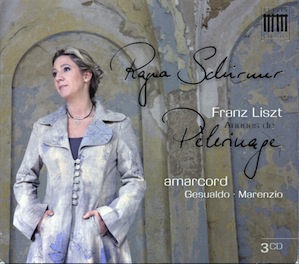
Années De Pèlerinage by Franz Liszt, performed by Ragna Schirmer.
ADHD Summary:
This three disc set is Ragna Schirmer's most recent recording, and it was released on October 11, 2011 in the United States. Certainly, this could become regarded as the definitive performance of Années De Pèlerinage, or Years of Pilgrimage. It is well recorded, complete, and interestingly presented as a concept album with somewhat related madrigals.
The Music:
Years of Pilgrimage is a set of three collections of solo piano pieces by Franz Liszt. They were published in 1855, 1858, and 1877, but like all of Liszt's works they have their beginnings as early as the mid-1830s, with various versions existing in different stages of being entirely finished. As you might guess from the dates, the third volume ("Third Year") is a different experience from the first two. Any complete presentation, including this one, usually includes three pieces known as "Venice and Naples" that date from the 1850s.
The collection includes well known pieces, such as "Après une lecture du Dante" (a.k.a., the Dante Sonata) and "Au lac de Wallenstadt," that are sometimes performed separately (and often). As a whole, it includes a little less than two and a half hours of piano music that form an emotional journey through life and times as well as the places that inspired each piece.
Schirmer's recording is divided across three CDs, one for each year, and includes eight madrigals by Gesualdo and Marenzio interspersed just before the pieces to which they pertain, much as the chorus in a Greek play comments on the action. Schirmer has been doing these "concept albums" for a while now, presenting pieces of music that are related to each other, and yet contrast.
The performance:
First, let's discuss the madrigals performed by Amarcord. The eight are uniformly excellent, and I will be purchasing other recordings by this small ensemble. The voices are presented up front, but without a trace of the off-sounds produced by the microphone's proximity. In short, there is nothing much to say beyond, "This is as good as it gets."
Schirmer shares with Glenn Gould the ability to clarify lines of music in complex pieces that are always on the verge of becoming musical noise in the hands of less skilled performers. And she does not sing along. This makes her particularly suited to music that, even when quiet or slow, can have several things going on at once.
Some of the highlights in this performance are Year One's "Orage" and "Le Mal Du Pays," two very different works; Year Two's Sonnets of Petrarch; and the two pieces named "Thrénodie" in Year Three.
For comparison on all the pieces, I turned to Leslie Howard's performances on Volumes 39, 43, and 12 of his Liszt marathon late in the previous century. As a set, the Schirmer performance has much more unity, and I can't help but wonder if this unity comes from recording it all at once, at the same point in her career as a pianist, where Howard recorded his set over a period of five years during which he recorded thirty five hours of Liszt's other music? Schirmer has a generally lighter touch with the fast and dense parts, and that considerably assists with their appreciation by me.
Of course, the more popular works have a lot of other recordings to choose from. Hélène Grimaud recorded the Dante Sonata on her debut album, and it is a particularly fine performance of a showpiece. Horowitz loved Liszt, and while the performances are good, the recordings that I have are so bad that the sound conflicts with my enjoyment. Hough's recording of Year 1 on Hyperion is a fine one, and there are budget sets with Jenö Jandó on Naxos, as well as reissues from the later part of the analog era.
If you are only going to have one set, and particularly if the music is new to you, I recommend Schirmer.
The recording:
I discovered Schirmer while reading Fanfare Magazine a couple of years ago in which her recording of Händel's Keyboard Suites was mentioned in passing as being preferred to the disc under review. I bought it. I believe it may have been the first disc I purchased on Berlin Classics.
Like her other discs, this one is well recorded, with the microphones seemingly placed a little higher than usual above the piano. This placement (whatever it is in fact) produces a more natural sound when listening on headphones, while doing nothing bad to the sound when listening through the usual front speakers.
Whatever compression there is in the recording process is judiciously applied, and there are no artifacts at all -- the recording could easily pass for an SACD issue. The venue is not identified, but it is quiet: no planes, trains, or automobiles to be heard. Additionally, Schirmer is apparently able to play without breathing, or at least she makes no noise while doing so. Even the pedaling is quiet.
The liner notes:
Another beautifully produced and printed, but awkward release from Berlin Classics. The cardboard folds out twice, with three discs in a row to the left, and the liner notes glued to the fourth position. It is difficult to read the text. The booklet contains information (apparently written in part by Schirmer) about the pieces, and several strange photos of the back of Schirmer's head as she gazes toward the object of interest along with us, and photos that are too small (about the size of a postage stamp) to really be seen. I am sure it must have looked good before it was printed, still in the publishing software on a monitor that was 2560 pixels across.
The English is easy to find, with a little bit on each page, and it says the same thing as the German does, unlike albums where there are different write-ups for each language.
To get this disc
| Label: | BERLIN CLASSICS |
| ASIN: | B005HLJMA6 |